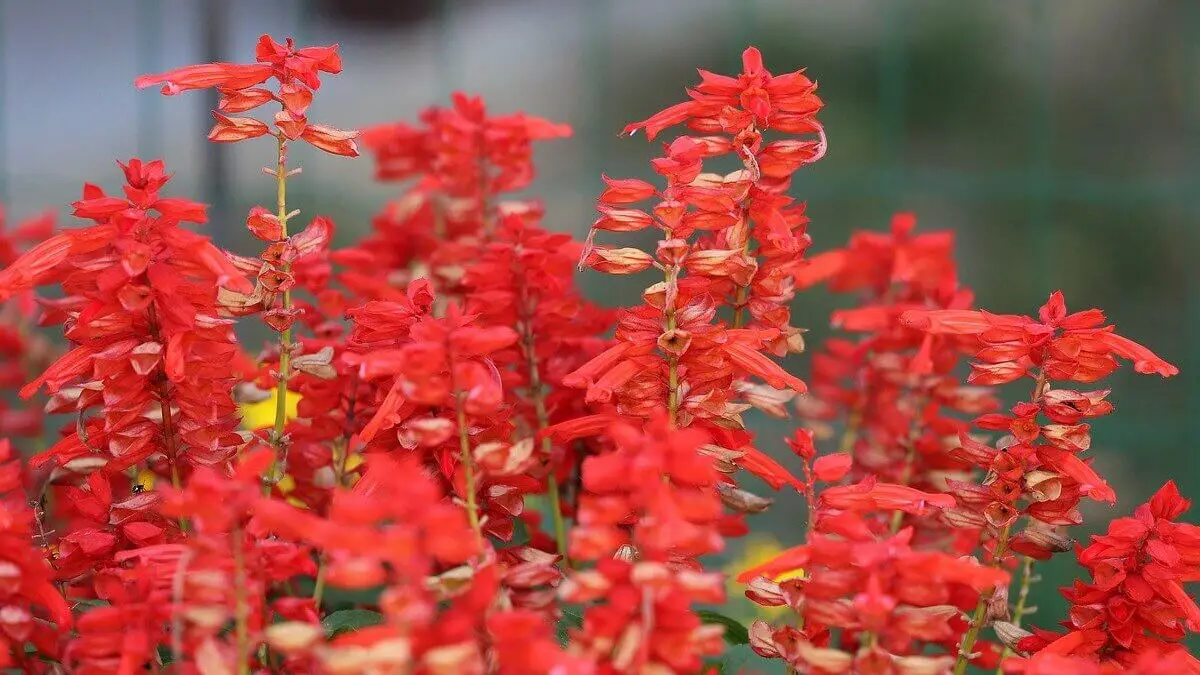How to Grow Red Salvia (Scarlet Sage) Plants
Red salvia has many names including Scarlet Sage and tropical sage. However, the plant taxonomy categorizes it as Salvia splendens. This ornamental herbaceous plant is native to mountainous regions of brazil.
This article focuses on Red Salvia (Scarlet Sage), Its description, propagation, harvest, and uses.
In Brazil, this plant grows at an altitude of 2,000 to 3,000 meters (6,600 to 9,800 feet). This region usually has high humidity and a warm climate throughout the year.
Table of Contents
Characteristics of Red Salvia (Scarlet Sage)

Photo by Carl Lewis (CC BY 2.0)
Generally, Red salvia (Scarlet Sage) plants tolerate drought, heat, and rough weather. They usually grow 18 to 30 inches (1.5 to 2.5 feet) tall. You can see them commonly, decorating public places like parks, shopping malls, Etc., However, some wild forms of these plants can grow up to 1.3 meters (4.3 feet) tall or more. Gardeners grow them very rarely.
These plants are popular for their showy, strikingly beautiful flowers. Also, the blooms have different colors depending on the cultivar types. They may be lavender, purple, pink, white, salmon, red, and orange. These flowers grow on 4 – 5 inches spikes.
The dark-green leaves usually form below the flower spikes. They measure almost 3 inches long and have a heart shape. These leaves exhibit an odor that most mammals do not like. Hence, these plants can repel most mammals including rabbits and deer.
Growers in hot regions, including brazil, cultivate these plants as perennials. Growers in temperate areas cultivate them as annual plants. It is because these plants cannot survive freezing climates.
Propagation of Red salvia (Scarlet Sage)
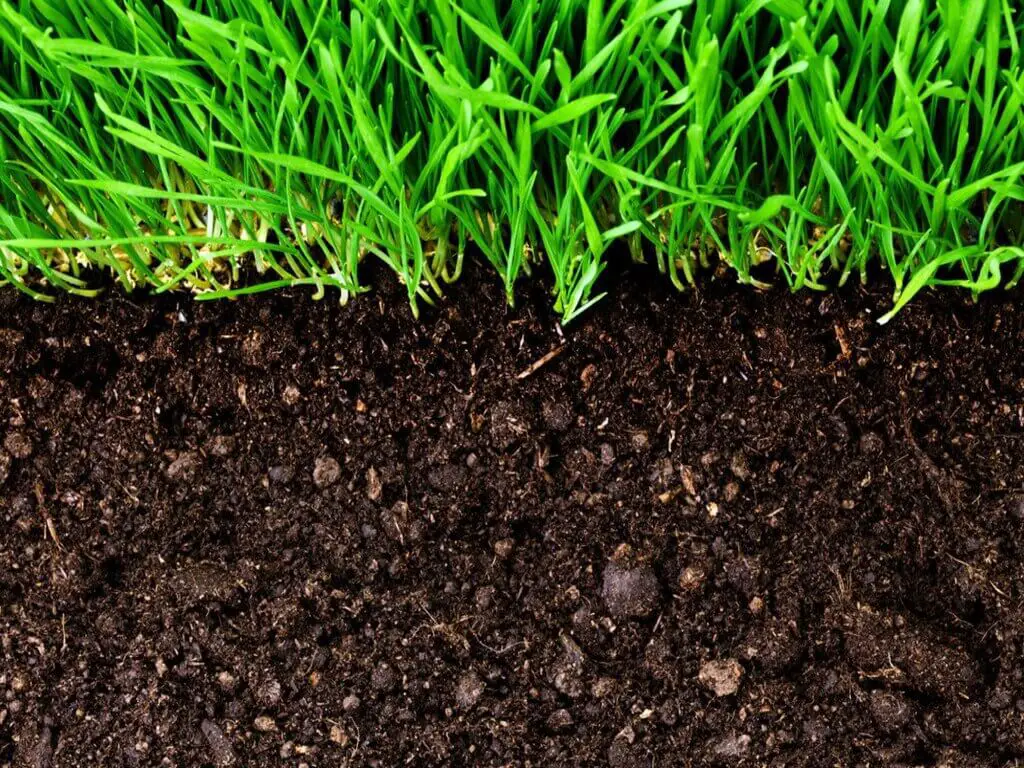
Photo by MerileyR (Wikimedia Commons) (CC BY-SA 4.0)
Red salvia (Scarlet Sage) plants prefer to grow under full sunlight. They can tolerate partial shades too. However, they can produce maximum yield growing under direct sunlight.
These plants are not picky about the soil. But they prefer to grow in loamy soils that drain well. These plants do not require fertilizers. Still, we recommend you to amend the soil with compost before planting
Seeds
You can purchase good quality seeds from online stores such as Amazon or any general nursery nearby. Make sure to buy them from reputed vendors. Most seed packs contain sowing instruction and contact details of the manufacturer.
Start sowing the seeds indoors, a couple of months before the average last frost date. Make sure the potting soil used is of good quality. Just sprinkle the seeds on the soil and cover them with a thin layer of soil. They require light for germination. Water moderately at regular intervals.
You can expect germination in about 2 -3 weeks.
After the sprouting of seedlings, keep the seedlings near a sunny window. You can also provide lighting from fluorescent bulbs. Remember, the plants need some dark hours too for growing. Hence, turn the lights on for about 16 hours. Turn the lights off for about the remaining 8 hours.
Feed the seedlings with starter solution (half strength food) when they are 3 weeks old. Make sure to follow the instructions that come with the package.
Harden off’ the plants for a week before transplanting to the outdoor garden. After that, you can transplant them in your gardens, or grow them in pots outdoors.
To reduce the transplant shock, we recommend you to transplant during late afternoons or on cloudy days.
Alternatively, you can sow the seeds directly into the garden beds, if you live in warm areas.
Seedlings
The easiest method is to buy a desired colored flowering Red salvia (Scarlet Sage) from a nearby nursery and transplanting it.
Make sure to dig a hole that measures twice the diameter of the pot and as deep. Remove the plant carefully from the purchased pot. Place the plant in an upright position into the hole. Then, Backfill the soil tightly.
Water the plant moderately. Avoid overwatering or underwatering. Add mulch around the planting area. This deters weed growth and helps maintain soil moisture.
Division
You can also try dividing existing Red salvia (Scarlet Sage) plants. It is advisable to try this method, only if you live in warm areas, where you grow them as perennials.
Dig out the existing plants. Divide the roots using a sharp shovel. Plant the divisions in separately dug holes. Water them moderately at regular intervals.
Try this method before plants start the new growth. This simply means, try this method during winter or early spring.
Caring of Red Salvia (Scarlet Sage)
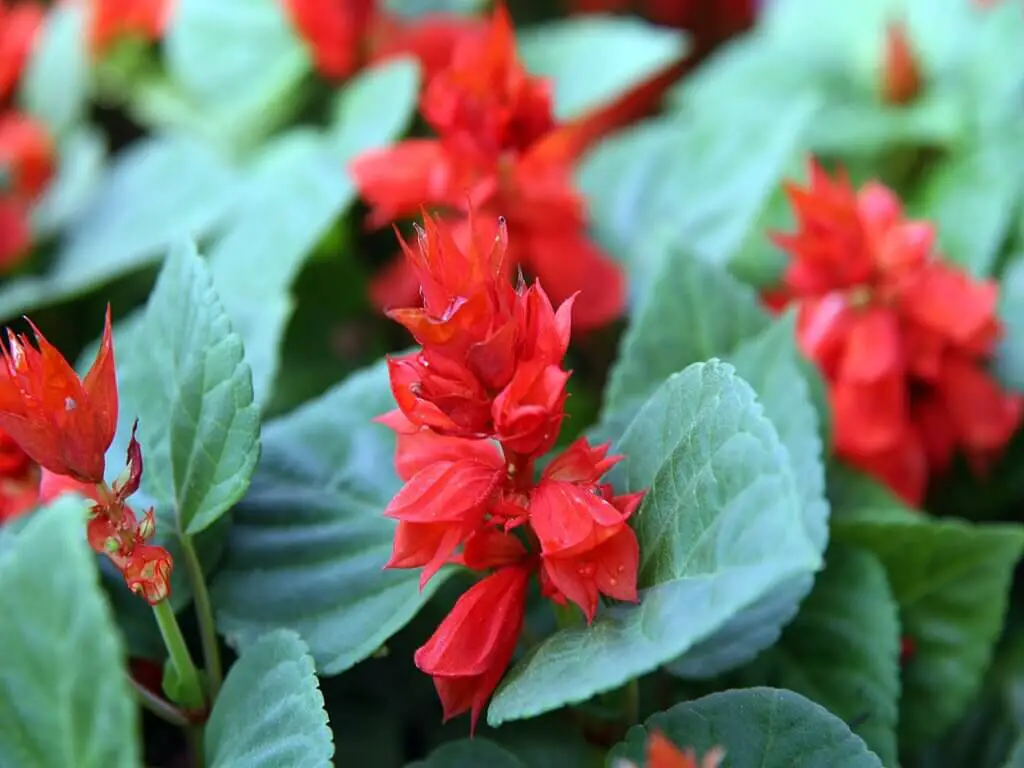
Photo by David J. Stang (Wikimedia Commons) (CC BY-SA 4.0)
It is a common practice among most gardeners to prune the Red salvia (Scarlet Sage) at least two times a year. This practice encourages healthy, fresh growth. Simply, Prune before the blooming starts in winter and again during the fall.
In addition, remove the faded blooms throughout the summer. This encourages fresh growth and also extends the blooming season. Generally, we recommend you to use good quality garden shears to perform these kinds of jobs.
Although this is a drought-tolerant plant, water moderately at regular intervals.
It is advisable to perform a soil test before the application of any fertilizer to the soil. Generally, you can use a good quality balanced fertilizer to the soil occasionally. This practice helps all plants planted in the soil, including Red salvia to grow healthier.
Pests and Diseases
Generally, Red salvia (Scarlet Sage) plants are disease-free and pest-free plants. Still, there is a probability that they may be infested by some common pests and diseases.
There are some best practices by following which, you can avoid most of the common diseases and pests. We have mentioned some of them below:
Prune the plants regularly as required by the variety. This facilitates the airflow around the plants.
Water during the early morning hours, aiming at the base of the plant. Avoid watering the foliage. This facilitates the plants to dry making use of day time heat, before the arrival of cool evening weather.
We recommend you to use a trickle or drip watering system to water the plants if possible. This reliable system delivers water at soil levels with low pressure. As a result, the plant gets adequate water eliminating risks.
Amend the soil with recommended (light) fertilizers and manures occasionally. This helps to boost the healthy growth and natural resilient properties of the plants.
Remove the weeds around the plants regularly with a good weeder. Cover the plant surroundings with mulch. This helps check weed development.
Rake the garden as needed. Remove and dispose the debris off immediately. Always maintain cleanliness.
It is always recommended to keep a good guide handy for dealing with common pests and diseases.
Diseases
Alternaria Leaf Spot
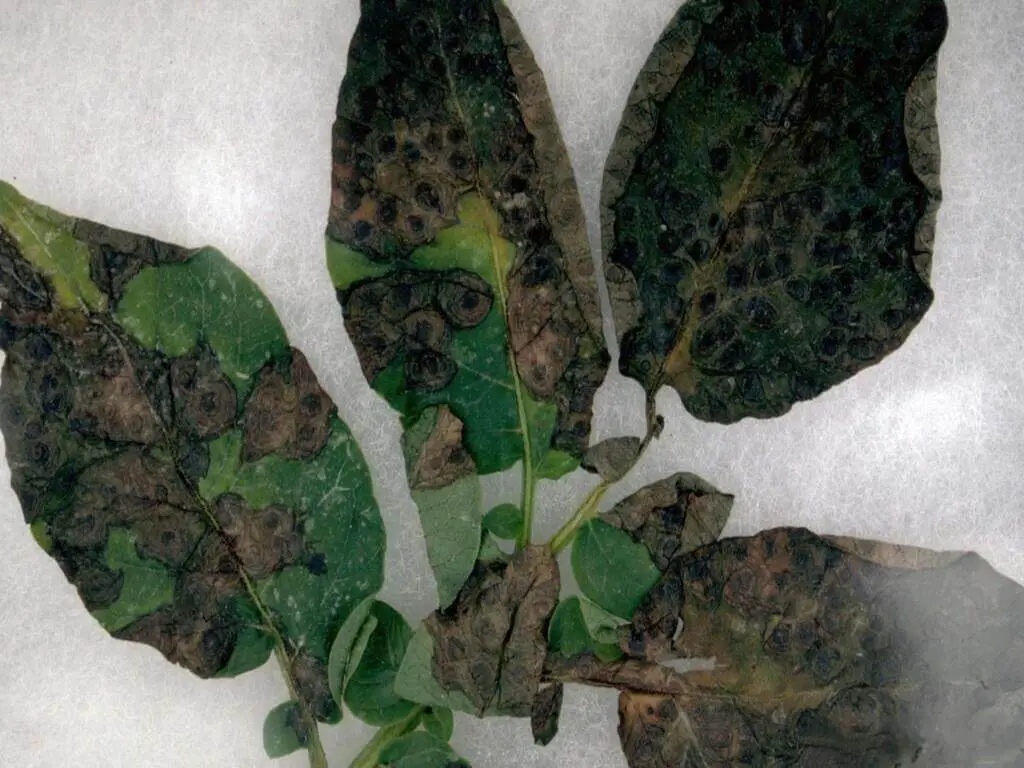
Photo by Howard F. Schwartz (Wikimedia Commons) (CC BY 3.0)
Generally, the affected foliage develops tiny reddish-brown circular spots with grey or white centers on the upper surface of the foliage.
Normally, this disease infests during hot, wet, and humid conditions. Hence, aim to water the roots rather than the foliage.
Treat the infested plants with fungicides. If treatment fails, dispose the infested plants off immediately.
Botrytis
Usually, this fungal disease causes greyish molds on stems, buds, flowers, and leaves.
Normally, this disease infests during cool, wet, and humid weather. Avoid foliage while watering. Aim at the roots.
Treat the infested plants with Neem Oil spray (RTU Spray – 32 oz). If treatment fails, prune off the affected parts. If it spreads to the whole plant, dispose the plant off immediately.
Damping
Generally, this disease is caused due to a soil-borne fungus. The seedlings grow normally, but suddenly wilts and fails. This also shows the soil has high nitrogen content or too moist.
Prune the plants to facilitate adequate airflow. This helps to prevent fungus to a certain extent.
In fact, this disease has no cure. Just dispose the entire plant off. Then treat the soil with good fungicide or neem oil. This may help to check the fungus.
Powdery Mildew
Normally, this fungal disease infects plants under humid conditions. It forms a whitish powdery substance on foliage. As a result, the foliage curls and dies.
Prune the plants and allow adequate airflow to prevent this disease.
You can use fungicides, sprays, and neem oils to treat this disease. If treatment has no positive effect, remove and dispose the plants off immediately.
Pests
Aphids

These pests have different colors including black, peach, red, or green. They suck the sap out of the foliage after eating through them. These dug canals, in turn, attract numerous plant diseases. In addition, Aphid’s excreted substance attracts ants and other pests
By growing beneficial insects attracting plants nearby, you can keep aphid under check. You can also use insecticidal soap and aphid sprays to treat them.
Spider Mites
Mostly, these tiny sap-sucking insects are brown, black, yellow, or red. They inject toxins into foliage, causing white dots on them. As a result, the foliage turns yellowish, dries, and finally dies. Sometimes, you can see webs develop on infected plants. These insects multiply quickly, ruining the whole plant.
Spray hose water forcefully on spider mites to remove them. You can treat these pests with spider mite sprays or insecticidal soap.
Thrips
Thrips are common plant pests. These minute insects have fringed wings and uniquely structured asymmetrical mouthparts. Most of them feed on sucking sap from foliage. A few of them are predators too! The affected foliage turns splotchy, pale, or silvery and dies finally.
You can treat thrips with mild insecticides or neem oil sprays. Make sure to snip off the infected parts of the plant.
Whitefly
Usually, these tiny white flies rise up in clouds when the host plant is disturbed. Generally, they spread common diseases among plants.
Blast off hose water on the plants to get rid of these flies. Use insecticidal sprays on the plants, particularly the underside of the leaves. This prevents them from attacking again.
Cultivars of Red Salvia (Scarlet Sage)
Most widely, the Red salvia (Scarlet Sage) plants are grown as ornamental plants. They have many cultivar varieties that sprout blooms in various colors including white, purple, pink, and red.
Among them, the dwarf varieties are popular. They have common names like Salsas or Sizzlers. Some of the Red salvia (Scarlet Sage) varieties are listed below:
Atrosanguinea – Dark red Flowers
Atropurpurea – Purple to dark violet flowers
Bruantii – Red Flowers
Bicolor – Red and White Flowers
Compacta – Red or white Flowers in dense racemes
Grandiflora – Large size flowers usually, Red
Issanchon – White flowers (usually with red or pink strips)
Nana – This is a very old cultivar with Red flowers
Semperflorens – Flowers with various colors.
Scarlet Pygmy – This a famous Dwarf variety with Red flowers (scarlet blossoms)
St. John’s Fire – This dwarf, early-flowering variety is famous for its lasting blooms – It Mostly sprouts Red flowers
S. splendens ‘Alba’ – Mostly, White flowers
Souchetii – Red or White flowers
Violacea – Purple to Dark violet flowers
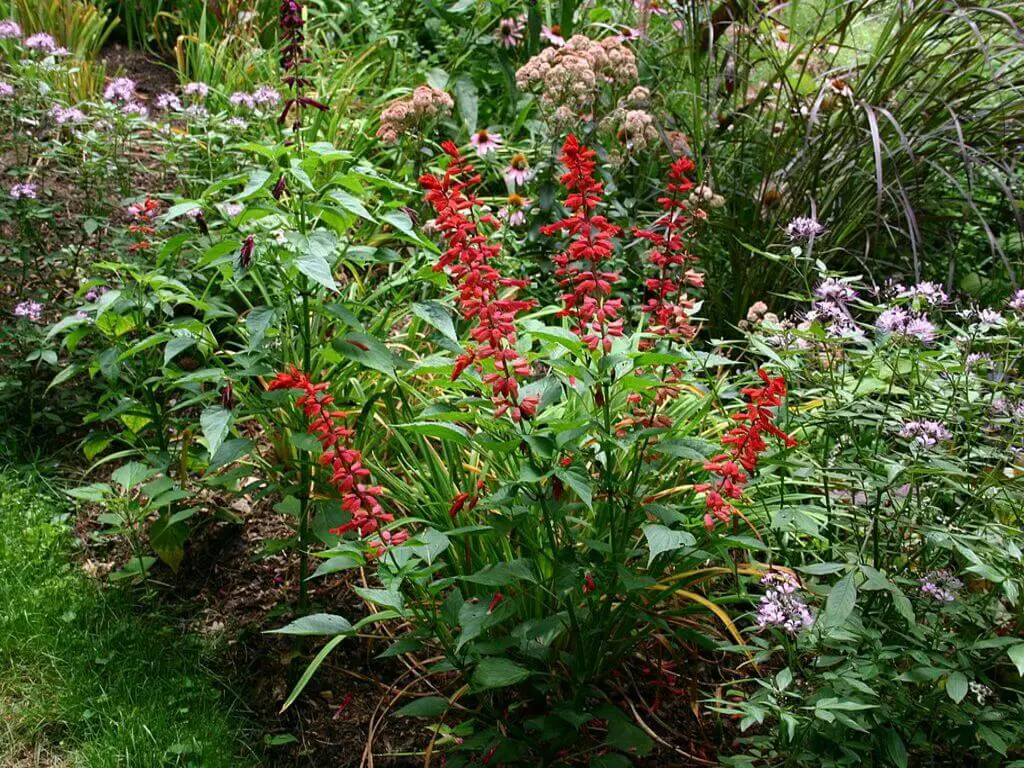
Photo by SB_Johnny (Wikimedia Commons) (CC BY-SA 3.0)
Among all these cultivars, Van Houttei variety is hugely popular for its showy red flowers. This cultivar grows 1 – 1.3 meters (3.3 – 4.3 feet) tall. The Royal Horticultural Society honored this variety with its “Award of Garden Merit”
Uses of Red Salvia (Scarlet Sage)
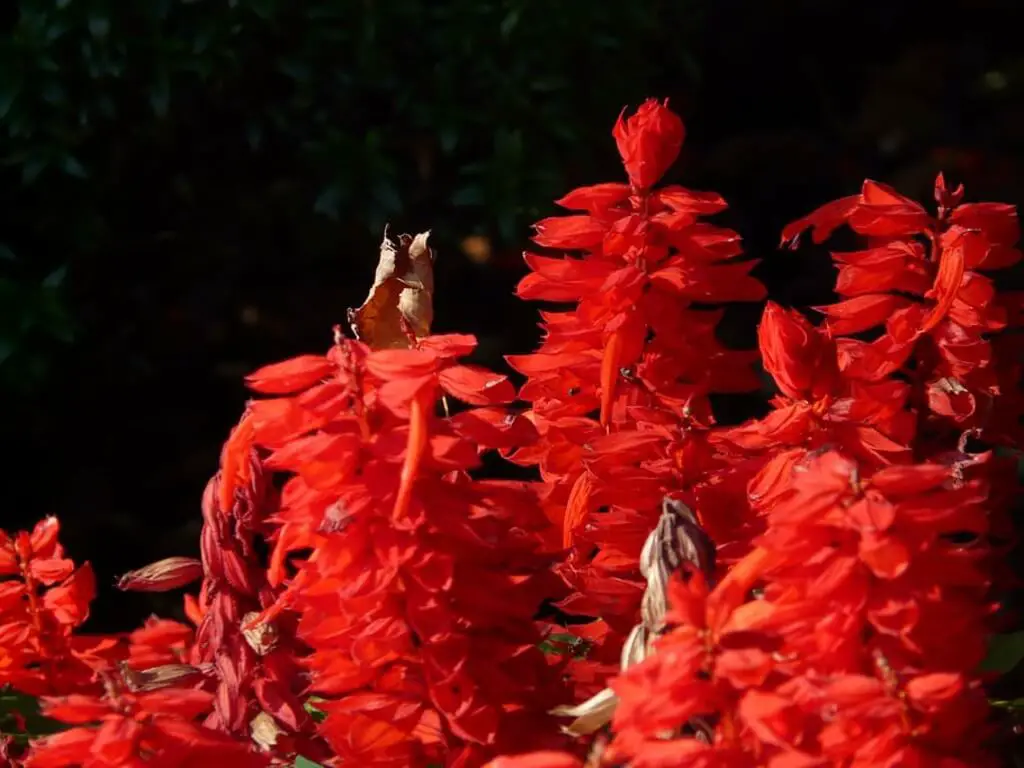
Ornamental usage
Mostly, gardeners grow Red salvia (Scarlet Sage) plants as ornamental plants. The flowers of these plants provide an excellent combination of cut flower packages.
Some landscape architects recommend to plant them in masses as bedding plants. If feasible, they also recommend growing them in rows as edging plants. These arrangements provide spectacular sceneries in large garden spaces.
In the USA, during the Memorial Day celebrations (4th July), the organizers use Red salvia flowers along with other flowers to showcase their flower displays. Also, you can find them commonly, decorating large shopping malls and other public parks.
These plants also form valuable additions in containers gardens with their striking vertical accent. Usually, the dwarf varieties surround them to provide beautiful views.
The combination of impatiens, geraniums, and red salvia can provide mesmerizing views to your gardens. In addition, red salvia can beautify your gardens even after summer, with fall flowers.
Medical usage
Traditional medical practitioners, particularly from India use Red salvia (Scarlet Sage) leaves for treating diabetes mellitus, cold-related disorders, and also for dressing wounds. They also use Red salvia seeds as an emetic for treating hemorrhoids, colic, and dysentery.
Some form of traditional medicals recommends Red salvia combination while treating psychoactive effects and meditative effects.
Similar Posts
How to Grow a Poinsettia Tree
How to Grow Pansy Color Plants

